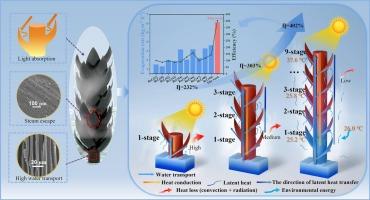层次化太阳能界面蒸发器源自天然多层植物叶片,用于高效海水淡化
IF 13.2
1区 工程技术
Q1 ENGINEERING, CHEMICAL
引用次数: 0
摘要
太阳能驱动的界面蒸发已经成为一种可持续的海水淡化策略。然而,在标准太阳能照明下实现高能量利用率和超快蒸发仍然是一个挑战。在这项工作中,我们提出了一种分层太阳能界面蒸发器,该蒸发器来源于碳化的天然植物叶片,它保留了固有的多层结构,包括维管通道、表面微纹理和层间孔隙度。这些结构有助于有效的水输送,广谱光吸收和快速蒸汽逸出。更重要的是,分层系统通过将太阳能直接吸收与被动式环境能源收集和潜热回收从上到下蒸发阶段相结合,实现了多级能源利用。因此,在没有外部能量输入的情况下,9级蒸发器在1个太阳(1 kW m−2)下实现了1 小时的6.12 kg m−2 h−1的异常高的蒸发速率,大大超过了传统单级系统的热力学极限。该系统在连续脱盐试验中也表现出优异的长期稳定性和排盐性能。本研究证明了利用炭化天然材料构建低成本、高效蒸发器的可行性,并为实际水净化应用中的多级能源利用策略提供了新的见解。本文章由计算机程序翻译,如有差异,请以英文原文为准。

Hierarchical solar interface evaporator derived from natural multilevel plant leaves for high-efficiency desalination
Solar-driven interfacial evaporation has emerged as a sustainable strategy for seawater desalination. However, achieving both high energy utilization and ultrafast evaporation under standard solar illumination remains challenging. In this work, we present a hierarchical solar interface evaporator derived from carbonized natural plant leaves, which retain intrinsic multilevel architectures including vascular channels, surface micro-textures, and interlayer porosity. These structures facilitate efficient water transport, broad-spectrum light absorption, and rapid vapor escape. More importantly, the hierarchical system enables multistage energy utilization by coupling direct solar absorption with passive environmental energy harvesting and latent heat recycling from upper to lower evaporation stages. As a result, the 9-stage evaporator attains an exceptionally high evaporation rate of 6.12 kg m−2 h−1 for 1 h under 1-sun (1 kW m−2) without external energy input, significantly surpassing the thermodynamic limit of conventional single-stage systems. The system also exhibits excellent long-term stability and salt rejection in continuous desalination tests. This study demonstrates the feasibility of using carbonized natural materials to construct low-cost, high-efficiency evaporators and offers new insights into multistage energy utilization strategies for practical water purification applications.
求助全文
通过发布文献求助,成功后即可免费获取论文全文。
去求助
来源期刊

Chemical Engineering Journal
工程技术-工程:化工
CiteScore
21.70
自引率
9.30%
发文量
6781
审稿时长
2.4 months
期刊介绍:
The Chemical Engineering Journal is an international research journal that invites contributions of original and novel fundamental research. It aims to provide an international platform for presenting original fundamental research, interpretative reviews, and discussions on new developments in chemical engineering. The journal welcomes papers that describe novel theory and its practical application, as well as those that demonstrate the transfer of techniques from other disciplines. It also welcomes reports on carefully conducted experimental work that is soundly interpreted. The main focus of the journal is on original and rigorous research results that have broad significance. The Catalysis section within the Chemical Engineering Journal focuses specifically on Experimental and Theoretical studies in the fields of heterogeneous catalysis, molecular catalysis, and biocatalysis. These studies have industrial impact on various sectors such as chemicals, energy, materials, foods, healthcare, and environmental protection.
 求助内容:
求助内容: 应助结果提醒方式:
应助结果提醒方式:


